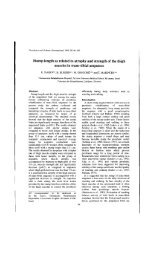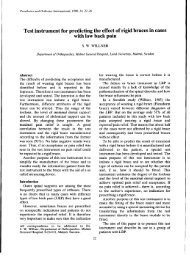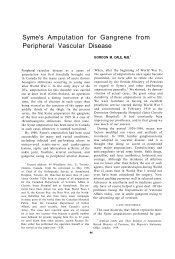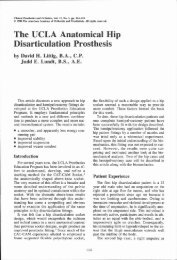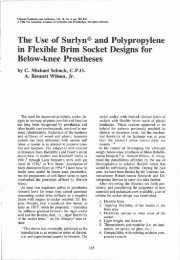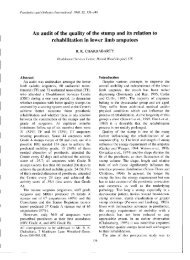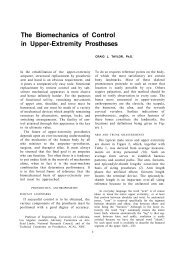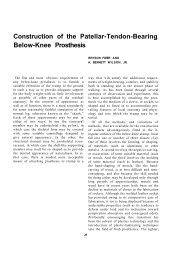Pro-Corn - O&P Library
Pro-Corn - O&P Library
Pro-Corn - O&P Library
Create successful ePaper yourself
Turn your PDF publications into a flip-book with our unique Google optimized e-Paper software.
Figure 1. Short Leg Walker.<br />
Purpose<br />
The purpose of this study was to determine<br />
the effectiveness of SLW and PTBW in reducing<br />
the pressure distribution on the normal<br />
foot during walking.<br />
Method<br />
Ten subjects (6 male and 4 female) without a<br />
history of foot pathology participated in this<br />
study. Capacitive pressure transducers‡ 2mm<br />
thick and 1.5cm in diameter were taped to the<br />
first metatarsal head (MTH), third MTH, fifth<br />
MTH, and plantar heel of the right foot of each<br />
subject (Figure 3). The foot was covered with a<br />
thin cotton stockinette which remained undisturbed<br />
during the study. Transducers were calibrated<br />
according to the manufacturer's instructions<br />
prior to testing each subject. Pressure recordings<br />
were made using a four-channel<br />
capacitive impedance bridge amplifier‡ and<br />
oscillographic recorder††† while subjects<br />
walked in a cast shoe (CS-1) (Figure 4), short<br />
Figure 2. Patellar Tendon Bearing Walker.<br />
leg walker (SLW), patella tendon bearing<br />
walker (PTBW), and again in a cast shoe<br />
(CS-2). All the walking devices were fabricated<br />
by the same manufacturer.† The cast shoe was<br />
identical to the foot component of both the<br />
SLW and PTBW, utilizing identical rocker outersoles<br />
and 2.4mm polyurethane material insoles.<br />
SLW and PTBW were applied to the leg<br />
with a 3/8" heel-shoe clearance. Subjects walked<br />
a distance of 100 meters for each treatment<br />
condition. The testing order of treatments<br />
SLW, PTBW, and CS-2 was randomly assigned<br />
to eliminate systematic error.<br />
Relative pressure was measured in millimeters<br />
of peak to peak chart deflection for 24<br />
steps for each treatment condition. The middle<br />
distance of each run was used for analysis in<br />
order to eliminate pressure variations due to the<br />
acceleration and deceleration phases of each<br />
trial. Percent pressure change relative to CS-1<br />
‡ Hercules Orthoflex Data System, Allegany Ballistics<br />
Lab, Cumberland, Maryland.<br />
††† Gulton TR-400a, Gulton Industries, Inc., East<br />
Greenwich, Rhode Island.



